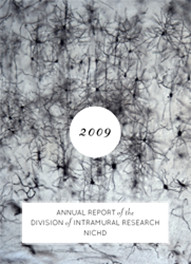New volume highlights accomplishments of NICHD’s Division of Intramural Research (DIR)

Does the circulatory system of a zebrafish develop in the same order as the circulatory system of a mouse or a human? How does the biology of a cell change in response to stress in the environment? How do color-vision circuits between the eye and the brain use chemicals to detect color? Why are the bones of people with Osteogenesis imperfecta so fragile? Are animals and humans "wired" to respond to an infant’s cry in the same way?
DIR investigators at the NICHD work to answer these and many other critical questions about human development, health, and disease. The Division’s 2009 Annual Report, released in April 2010, describes the progress of DIR researchers in addressing important health topics within the NICHD mission. This year’s report includes Scientific Highlights at NICHD and detailed descriptions of each investigator’s research.
The Division’s research programs address topics ranging from molecular and cellular biology, genetics, and endocrine and genetic disorders, to physical biology, neurosciences, immunology, reproduction, and behavioral research. Its projects are organized around the theme of the orchestration of life by molecular messengers.
"The breadth of the NICHD’s mission enables us to explore a broad range of critical research questions," said Constantine A. Stratakis, M.D., D(med)Sci., Acting Scientific Director of the NICHD and head of DIR. "Science advances by answering one question, which then leads to another and another. That is the fascinating nature of this work."
The NICHD has one of the largest intramural research programs at the NIH, with 79 tenured and tenure-track investigators, 79 units and sections within 11 research programs, and a total administrative and staff complement of 1,220 people.
Although basic research and laboratory studies are a large part of the DIR portfolio, the Division also conducts a great deal of clinical research—with human participants—and translational research to create practical applications for scientific discoveries. By including basic, clinical, and translational research in its portfolio, the Division can study multiple aspects of both fundamental and complex health topics.
Concurrent with its research activities, the DIR is also committed to supporting and training the next generation of investigators. Through its Office of Education, trainees can find fellowship positions and develop their academic and professional skills. These efforts include clinical training programs in pediatric endocrinology, medical genetics, endocrinology, maternal-fetal medicine, and reproductive endocrinology and infertility. In 2009, the DIR supported more than 350 trainees and fellows.
The NICHD’s DIR has a rich history of significant contributions to understanding of health and human development. The Institute is pleased to share highlights from the Division’s 2009 research activities.
For more information, select one of the following:
- 2009 DIR Annual Report
- DIR Home Page
- Previous DIR Annual Reports
- NICHD News Releases about DIR Research
Originally Posted: May 10, 2010

 BACK TO TOP
BACK TO TOP